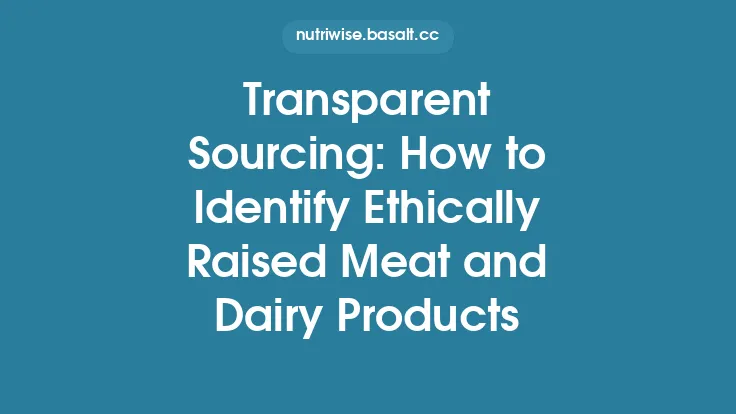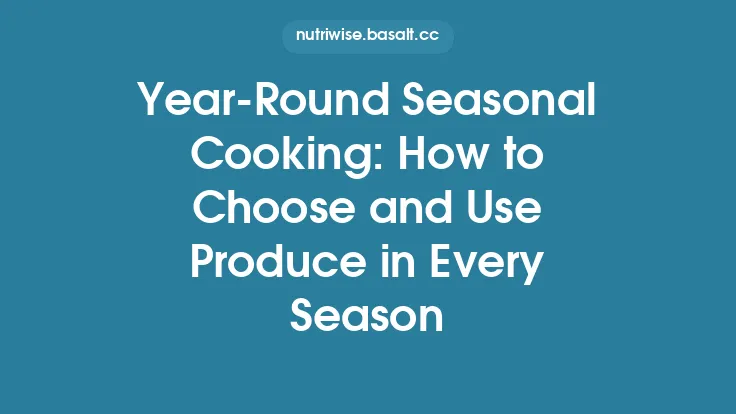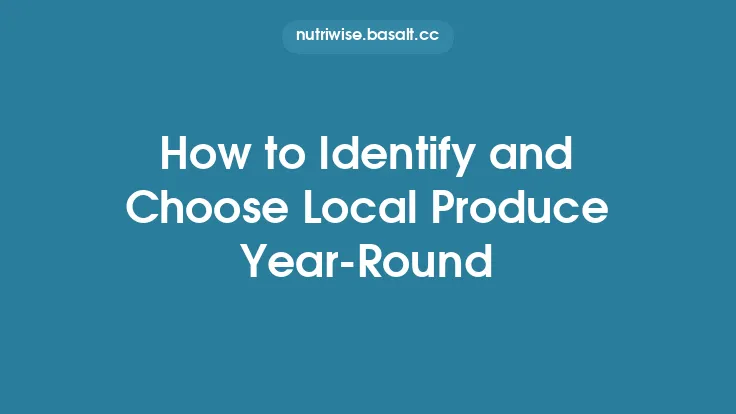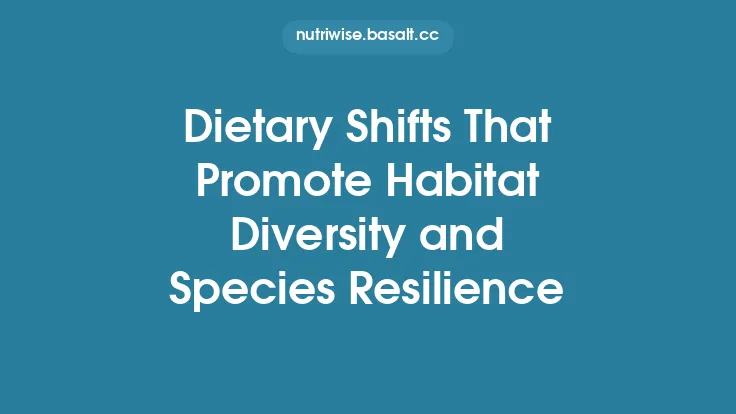The health of our oceans hinges on the choices we make at the market and the dinner table. While the allure of a familiar fillet or a prized shellfish can be strong, the underlying status of the species behind those products often goes unnoticed. Overfishing—when a fish population is harvested at a rate faster than it can replenish—has far‑reaching consequences, from collapsing ecosystems to the loss of cultural food traditions. By learning how to spot the warning signs of overexploited stocks and by selecting species that are harvested responsibly, consumers can become powerful allies in the effort to keep marine resources abundant for generations to come.
Understanding Overfishing: Core Concepts
Biological Overfishing vs. Economic Overfishing
- *Biological overfishing* occurs when the spawning stock biomass (the portion of the population capable of reproduction) falls below a level that can sustain maximum sustainable yield (MSY).
- *Economic overfishing* happens when fishing effort exceeds the point at which profit is maximized, often leading to increased pressure on already stressed stocks.
Maximum Sustainable Yield (MSY) and Its Limitations
MSY is a theoretical catch level that would allow a population to replenish itself indefinitely. In practice, uncertainties in stock assessments, environmental variability, and ecosystem interactions mean that MSY should be treated as a guideline rather than a hard ceiling.
Ecosystem-Based Management (EBM)
EBM expands the focus from single‑species quotas to the health of the entire marine ecosystem, accounting for predator‑prey relationships, habitat integrity, and cumulative impacts of multiple fisheries.
Data Sources for Assessing Stock Health
| Source | What It Provides | Typical Access |
|---|---|---|
| FAO FishStatJ | Global catch statistics, production trends, and species‑specific reports | Free downloadable database |
| NOAA Fisheries Stock Assessment Reports (U.S.) | Detailed scientific assessments, reference points (e.g., B<sub>MSY</sub>, F<sub>MSY</sub>) | Public PDFs on NOAA website |
| ICES Advice (European waters) | Stock status, recommended catch limits, and scientific advice for member states | Open‑access PDFs |
| IUCN Red List – Aquatic Species | Conservation status (e.g., Vulnerable, Endangered) based on population trends and threats | Online searchable database |
| Seafood Watch (Monterey Bay Aquarium) | Consumer‑friendly color‑coded ratings derived from scientific assessments | Interactive website and app |
| FishWatch (NOAA) | Species profiles, stock status, and management measures for U.S. fisheries | Web portal |
When evaluating a species, look for the most recent assessment and note whether the stock is classified as “healthy,” “overfished,” “subject to overfishing,” or “data deficient.” A “data deficient” label signals that information is lacking, and a precautionary approach (choosing an alternative) is advisable.
Red Flags: Biological and Fishery Indicators of Overexploitation
- Declining Spawning Stock Biomass (SSB) – A consistent drop in SSB over multiple assessment periods signals that the reproductive core of the population is eroding.
- Catch Per Unit Effort (CPUE) Decline – When fishers must work harder (more gear, longer trips) to catch the same amount, CPUE falls, indicating reduced abundance.
- Reduced Size-at-Maturity – Overfished populations often evolve to mature at smaller sizes, a biological response to intense harvest pressure.
- High Fishing Mortality (F) Relative to F<sub>MSY</sub> – If the current fishing mortality rate exceeds the level that would produce MSY, the stock is being overfished.
- Bycatch and Discards – While not the primary focus of this article, high bycatch rates can be a symptom of poorly targeted fisheries, often associated with overexploitation of the target species.
- Habitat Degradation – Species that rely on specific habitats (e.g., coral reefs, seagrass beds) may be overfished indirectly if those habitats are being destroyed.
Tools and Platforms for Consumer Insight
- Seafood Watch Mobile App – Offers real‑time, location‑specific recommendations. Users can search by common name, scientific name, or even by the restaurant’s menu.
- FishBase – A comprehensive database of fish species that includes life‑history parameters (growth rates, longevity, fecundity) useful for evaluating vulnerability.
- Global Fishing Watch – Visualizes vessel activity via satellite data, allowing consumers to see whether a fishery operates in a “high‑risk” area.
- Open Data Portals – Many national fisheries agencies publish raw catch data (e.g., Canada’s Fisheries and Oceans open data portal). Enthusiastic consumers can cross‑reference these datasets with market labels.
These tools empower shoppers to move beyond generic “sustainable” claims and make decisions grounded in the latest scientific evidence.
Evaluating Species: Life‑History Traits and Ecological Role
Not all fish are equally vulnerable to overfishing. Species with certain biological characteristics tend to be more resilient:
| Trait | Resilient Species | Vulnerable Species |
|---|---|---|
| Growth Rate | Fast‑growing (e.g., sardines, anchovies) | Slow‑growing (e.g., orange roughy) |
| Longevity | Short‑lived (<5 years) | Long‑lived (>20 years) |
| Age at Maturity | Early maturity (1–2 years) | Late maturity (5+ years) |
| Fecundity | High egg production (hundreds of thousands) | Low egg production (few thousand) |
| Trophic Level | Lower (planktivores, herbivores) | Higher (predatory, apex) |
Lower trophic level species typically have shorter generation times and can sustain higher harvest rates without destabilizing the ecosystem. Conversely, top predators accumulate contaminants and have slower population turnover, making them more prone to overexploitation.
Choosing Sustainable Alternatives: Criteria and Examples
When a preferred species is flagged as overfished, apply the following decision framework:
- Confirm the Status – Verify the latest stock assessment. If the species is “overfished” or “subject to overfishing,” move to step 2.
- Identify Ecologically Similar Options – Look for species that occupy a comparable niche but have healthier stock assessments.
- Check Life‑History Resilience – Favor fast‑growing, early‑maturing species.
- Consider Regional Availability – Locally abundant species reduce transport emissions and support regional economies.
- Assess Management Measures – Choose species from fisheries with robust, transparent management (e.g., catch limits, seasonal closures, gear restrictions).
Illustrative Substitutions (Note: these are examples; always verify current status before purchase)
| Overfished Target | Sustainable Alternative | Reason for Substitution |
|---|---|---|
| Atlantic Cod (Gadus morhua) | Pacific Hake (Merluccius productus) | Hake stocks are generally healthy and have similar flaky texture. |
| Bluefin Tuna (Thunnus thynnus) | Albacore Tuna (Thunnus alalunga) | Albacore is lower on the trophic ladder and has a faster turnover. |
| Chilean Sea Bass (Dissostichus eleginoides) | Patagonian Toothfish (same genus, but under strict quota) – *only if certified under a robust, independent audit* | When a certified, well‑managed fishery exists, the species can be a responsible choice. |
| Orange Roughy (Hoplostethus atlanticus) | Sardines (Sardinops sagax) | Sardines are short‑lived, abundant, and provide comparable omega‑3 benefits. |
| King Salmon (Oncorhynchus tshawytscha) – wild, overfished runs | Farm‑raised Atlantic Salmon (Salmo salar) – *only if sourced from low‑impact, closed‑containment systems* | While aquaculture is a separate topic, closed‑containment systems mitigate many environmental concerns and can be a viable alternative when wild stocks are depleted. |
Practical Steps for Making Informed Purchases
- Ask Specific Questions – “Is this fish from a certified sustainable fishery? What is the stock status?” Vendors who can’t answer may be sourcing from uncertain origins.
- Read the Scientific Name – Common names can be ambiguous. Knowing the Latin name helps you cross‑reference with assessment databases.
- Prefer Whole‑Fish Over Fillets – Whole fish often retain more traceability information (e.g., catch location printed on the label).
- Check for Transparent Origin Labels – Labels that list the country, region, and fishing method (e.g., “pole‑and‑line”) are more likely to be traceable.
- Use Mobile Apps at the Point of Sale – Scan the barcode or type the name into a sustainability app for an instant rating.
- Rotate Species – Even sustainable stocks can become pressured if demand spikes. Rotating your seafood choices spreads the harvest pressure.
- Support Data‑Rich Fisheries – Fisheries that publish regular stock assessments and management plans demonstrate accountability.
Beyond the Plate: Supporting Sustainable Fisheries Indirectly
While the focus here is on consumer identification and substitution, the broader market influences fisheries management. By consistently choosing species with healthy assessments, demand signals to regulators and industry that responsible practices are valued. Over time, this market pressure can encourage:
- Implementation of Precautionary Catch Limits – When demand for a species declines, fisheries may adopt stricter quotas to rebuild stocks.
- Adoption of Ecosystem‑Based Management – Demonstrated consumer interest in ecosystem health can motivate policymakers to integrate EBM principles.
- Investment in Research and Monitoring – Higher market demand for transparent data can lead to increased funding for stock assessments.
Maintaining Vigilance: The Ongoing Nature of Sustainable Seafood
Ocean ecosystems are dynamic, and the status of fish populations can shift with climate change, habitat loss, and evolving fishing practices. Sustainable seafood selection is not a one‑time decision but a continuous learning process. By staying informed through reputable data sources, leveraging consumer tools, and applying a systematic evaluation framework, you can make choices that protect marine biodiversity while still enjoying the flavors of the sea.
Remember: each informed purchase is a vote for a healthier ocean. The more we collectively prioritize species that are abundant, resilient, and responsibly managed, the stronger the foundation for future generations to enjoy sustainable seafood.





